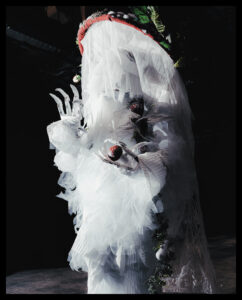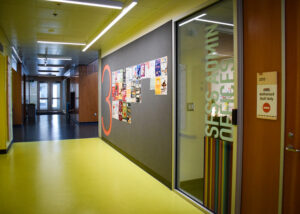SFU phasers were set to win at the 2014 VEX Robotics World Championship in Anaheim, California earlier this month, which invited top robotics teams from around the world to compete against “the best of the best.” Founded just last year by engineering student Gordon Ho, SFU’s VEX Robotics team was the only Canadian university team to compete.
The VEX Robotics World Championship included nearly 700 teams which qualified during competition tournaments held throughout the year. Midway through the season, SFU’s team was ranked #1 in the world in the skills challenges component and had earned enough points to be included in the top 30 university teams around the world.
Each year, the World Championship presents a different challenge to the competitors. The object of this year’s game was to attain a higher score than the opposing team by moving multiple coloured balls from around a field of play and transporting them to the goal areas.
The team began working on their robot last September. After many brainstorming sessions and team exercises, the group finally came up with a viable design. After that, Ho explained, “We actually drew the robot in a 3D CAD program called Google Sketchup. Then we printed out each subsection — drive, arm, and the manipulator — then members could pick up a piece of paper and start building it right away.”
The club met once a week in the Applied Sciences wing to work on their automaton, but limited space meant they had to improvise to reach the top. “We don’t actually have a field set up at SFU. We don’t really have a room. We just have a cabinet,” said team member Joanna Che, laughing. “That proved an extra challenge because we had to go all the way to Gladstone to borrow their playing field just to program our automatons.”
When designing their ‘bots, the team had to be conscious of the fact that they would have to transport both smaller BuckyBalls and Large Balls to different goals of varying heights. All this would have to be accomplished in just two minutes, while avoiding obstacles like speed bumps and going under 12-inch tall bridges.
Midway through the season, SFU’s team was ranked #1 in the world in the skills challenges component.
SFU’s robot was designed with standard four-wheel drive and a flexible mobile arm which can manipulate the different balls. Ho explained, “When the robot starts, it’s really compact because we needed it to fit in the 15 inch [limitation], but once it expands it can reach the full 24-inch goal.” The intake manipulator involves two rollers with rubber flaps which can adjust to the size of the ball to control it, and then another roller on top to adjust to and control the large ball.
“Mostly the balls are away from the goal area, so you have to collaborate with your partner [robot],” explained Che. Due to funding limitations, the SFU team ended up partnering with UBC’s robotics club in order to field the required team of two robots.
For the first minute of the game, a team is not allowed to directly control its robots. Instead, they have to rely on complex programming so that their robots can sense the boundaries of the space, find where the balls are, and drive to their destination. The second minute sees a driver controlling the robot directly.
“If you have a really good programmer, you can really get ahead of the game, because half of the game is programming,” said Ho.
Although the team placed 16th overall out of the 60 programming and driving teams, they dominated in the programming skills challenge. During this portion of the competition, teams have two robots on the field with no opponents and have to score as many points as possible in 45 seconds. The rub: the challenge is completely pre-programmed. With careful and precise preparation, the team took 4th place.
The team is already brainstorming for next year’s World Championship, which will task competitors to move and manipulate wireframe cubes into goals of up to seven feet. However, the team is ready to take off on their own — without UBC’s partnership. “For the next year, if we get enough funding, we’re hoping to have two teams going to the World Championships. So, we’ll have more teams from BC and Canada to represent at the World Championships,” Ho concluded.















